Anatomy of a Perfect Facebook Post: Exactly What to Post to Get Better Results
HOW TO WRITE A PERFECT POST ???
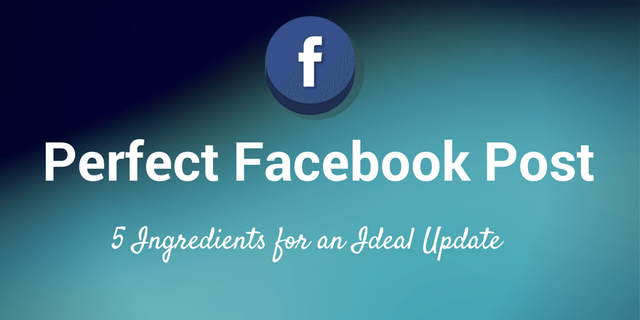
You post to your Facebook page, hoping you’ve hit upon something that works.
How great would it be know that the post you just published had the best chance of maximizing clicks, likes, and comments.
Facebook posts especially—given the dramatic dip in reach—can feel like a mystery. How do you create the perfect Facebook post? Does the perfect Facebook post even exist?
I went looking for answers and came across a heap of best practices and examples of what goes into a perfect Facebook post. Check out the results below, test out the tips and strategies on your own posts, and watch your Facebook stats climb.
facebook-ideal-post
The Anatomy of a Perfect Facebook Post
Right off the top, here’s what I found as the five ingredients that go into a perfect Facebook post. I’ll dive into more detail on each of these further down in the article.
A perfect Facebook post:
is a linkis brief—40 characters or fewer, if you can swing itgets published at non-peak timesfollows other posts on a regular scheduletimely and newsworthy
Several Facebook pages have found great success with this particular style of post. Take this one from The Muse, for example (a Facebook page that routinely engages 50 percent of its fans per post). It nails the elements of post type, length, and imagery.
Of course, as with all of the best practices mentioned below, you can take them as a jumping off point to your own experiments and tests. I’ll be testing them, too, on the Buffer page and looking forward to sharing with you the results later on.
Let’s get into a bit more detail about each perfect ingredient.
- A perfect Facebook post is a link post
The data here is pretty compelling:
Link posts that use the built-in Facebook link format receive twice as many clicks compared to links typed into a photo update.
The data comes from Facebook itself, which performed studies on the number of clicks for different post types. Their findings suggest that link format trumps photos, and their guidelines point to a post type—status, photo, link, video—that fits the story.
When sharing content on Facebook, the choice is often between sharing as a link and sharing as a photo. It would seem the best results will come from links.
So what does a link post look like compared to a photo post?
And how can you publish one and not the other?
Link posts take advantage of meta tags from the webpage, including information on the page’s title, description, and photos. When you paste a link into the update box on your Facebook page, Facebook will pull this information in automatically and place it in a link format. Here’s an example from the Buffer page.
buffer-facebook
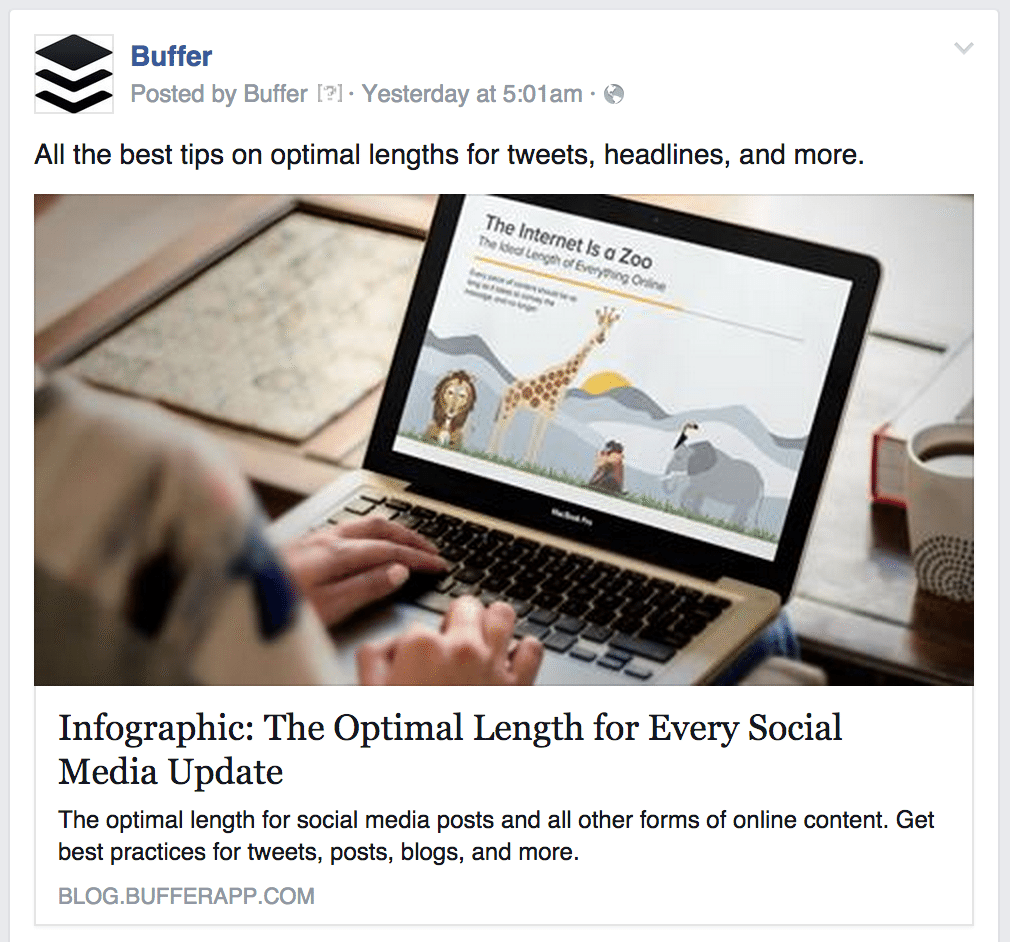
Photo posts require that you upload and attach a photo to your update. The photo stands alone, underneath the custom text that you choose to add. You can include a link in the custom text as well (these are the links that fail to get the better click rate compared to link posts).
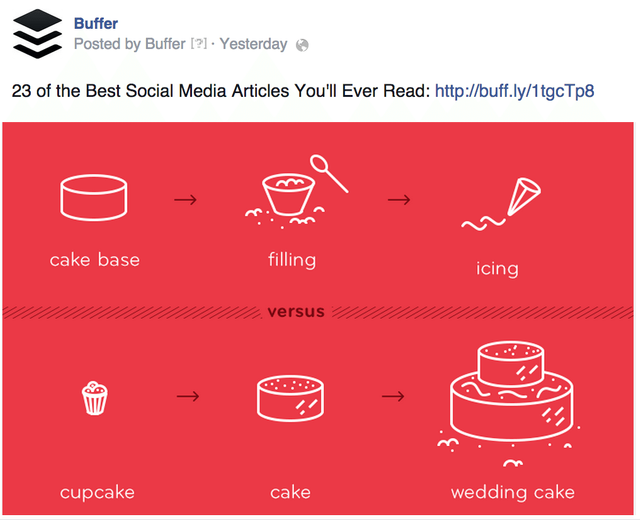
Screen Shot 2014-10-27 at 11.03.56 AM
The way to create a link post might not be immediately clear from the update composer on Facebook. When you’re writing a new update, you won’t see an icon to enter a link. The options up top are for Status, Photo/Video, and Offer/Event.

facebook page composer
To share a link, copy and paste a URL into the composer window.
After a second or two, Facebook will display the link’s meta information—title, description, and photo.
Once this happens, you can delete the URL out of the composer window and type in your own catchy intro.
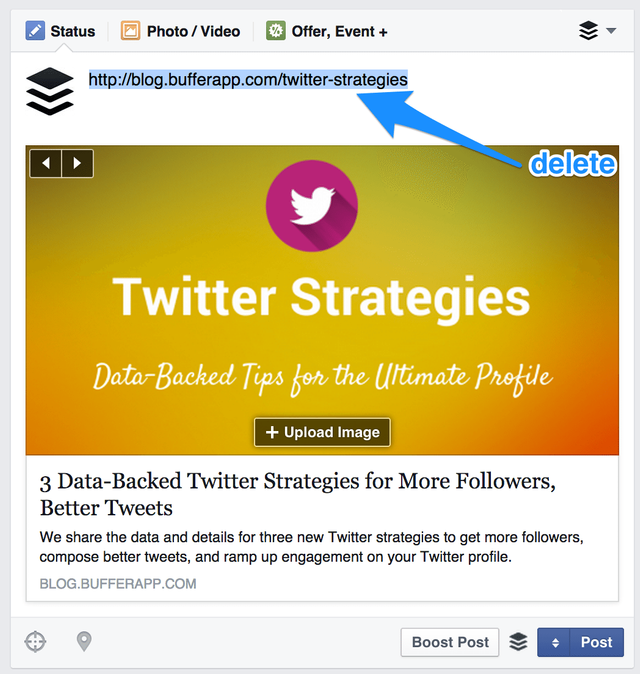
buffer-fb-post
To get things looking exactly right with the link that you share, you can control the text and image by editing the open graph tags on your page. We’ve written here about how this whole process works, and if you want to check your progress before publishing an update, you can plug in your URL into the Facebook Open Graph Debugger tool to get a preview (and check to see what might need fixing).
As far as what to type (and how much to say), there’s a perfect amount for that, too. - A perfect Facebook post is short, as little 40 characters if at all possible
Posts at this length tend to receive a higher like rate and comment rate—in other words, more engagement.
A Buddy Media study of 100 top on Facebook found that 40 characters or fewer receives the most engagement on average (it also happens that these ultra short posts are the least frequent types of posts on Facebook).

Screen Shot 2014-10-28 at 6.02.22 AM
Other studies have confirmed the “shorter is better” maxim. BlitzLocal studied 11,000 Facebook pages and found that engagement increased as posts got shorter. Track Social noticed the same effect in its study: So-called “tiny” posts of zero to 70 characters saw the most likes, comments, and responses.
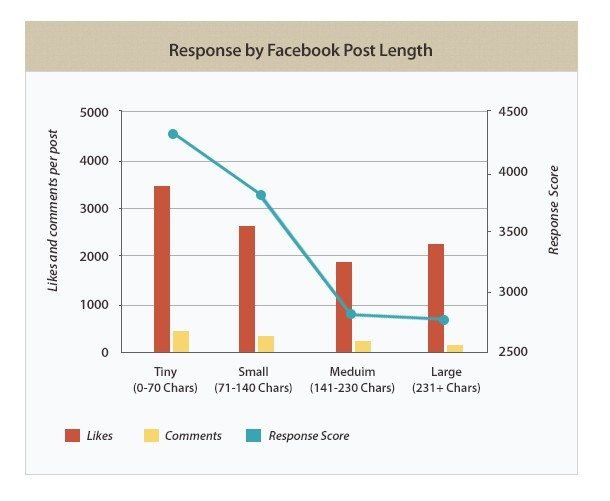
fb-chart
Forty characters doesn’t sound like much. What type of a message can you fit into your post with so little space?
Here are a couple examples:
moz FB example
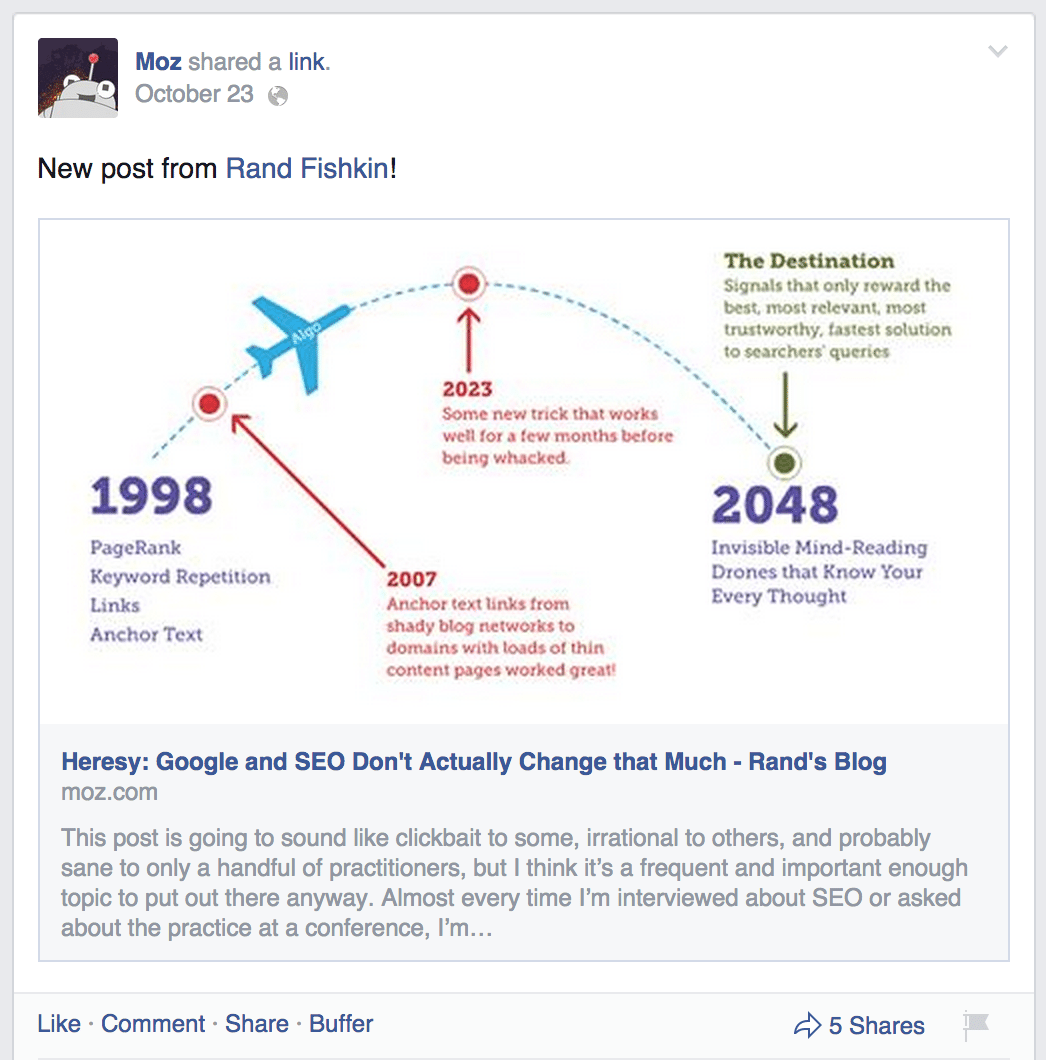
(27 characters)
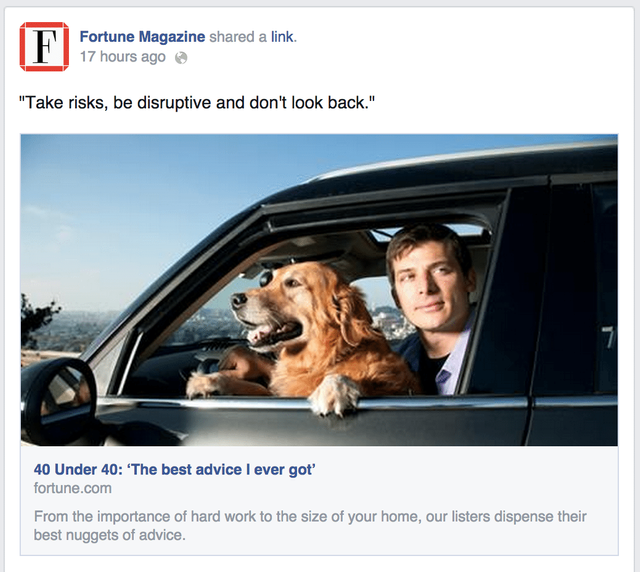
Fortune example FB
(48 characters)
And keep in mind that you’ll also get to use the link’s title and description text to entice readers to click, comment, and engage. The 40-character intro is more of a teaser, supplemented by the text in the link itself. - A perfect Facebook post is sent at non-peak hours
The thought process goes like this: You compete with hundreds of thousands of posts to be seen in the Facebook News Feeds of your fans. If you post your updates when few others are posting, your updates stand a better chance of making it through.
We’ve referred to this “Late Night Infomercial Effect” before. And Track Maven found some data to back it up.
In their study of 5,800 pages and over 1.5 million posts, Track Maven came up with best practices and advice for brands. Among the tips, post on Saturdays and Sundays and post after regular work hours.
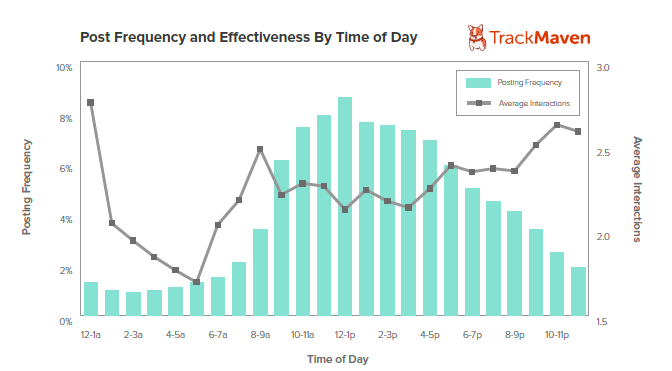
In order to land a spot on a user’s Facebook News Feed, try shifting your scheduling strategy from posting during the most popular times in the workweek to the most effective times.
Graph1PostFreqandEffectTOD
The best window for a workday is 5:00 p.m. to 1:00 a.m. Eastern Time. For another bump in engagement, try posting on the weekend.
Here’s a helpful infographic, created by HubSpot and Track Maven.
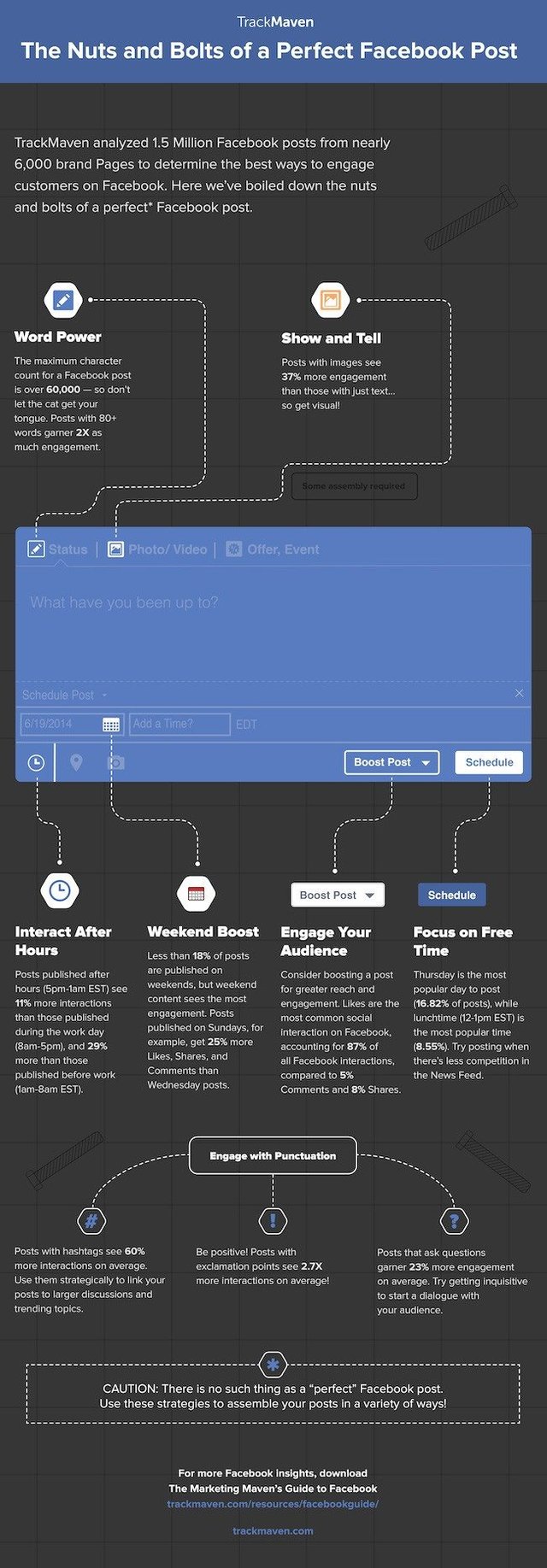
080514_The-Nuts-and-Bolts-of-Facebook - A perfect Facebook post is part of a consistent sharing strategy
Mark Schaefer and Tom Webster analyzed data on 8,000 Facebook pages (data courtesy of AgoraPulse) to identify how brands were impacted by the apparent drop in organic reach. They came away with some intriguing stats (more than 70 percent of pages had a 30 percent or more decline in organic reach) and some best practices from the handful of pages that are succeeding.
In particular, they focused on four pages that had found success and the four characteristics that each page had in common:
They target an audience with a strong passionThey publish very good content (at least, very good for their target audience)They publish very consistently (at least once a day, often more)They get a LOT of shares (thanks to the 3 points above), and shares are what offers the highest level of “viral” visibility for a page’s content.
Let’s assume you have an audience that is passionate about your page (which is why they became fans, right?).
Let’s also assume that you are publishing good content.
What’s the key third ingredient?
Consistency.
The successful pages in this study posted at least once a day, creating an expectation among its fans of consistent, quality content. There are several ways of staying on schedule with your Facebook posts; set up a content calendar or sign up for a free scheduler like Buffer. Then start filling your queue with quality content. - A perfect Facebook post includes a newsworthy element (optional)
This last point might not apply to some brands whose content and industry don’t lend itself well to timeliness. Still …
If there’s ever a way to slip in a newsworthy angle to your Facebook post, do so.
Facebook’s latest tweaks to its News Feed algorithm give a slight boost to timely, trending topics.
We’ve heard feedback that there are some instances where a post from a friend or a Page you are connected to is only interesting at a specific moment, for example when you are both watching the same sports game, or talking about the season premiere of a popular TV show.
Facebook is making this update in two ways:
Factoring in trending topicsLooking at when people like or comment on a post
The first element is related to Facebook’s “trending” section of the site, which identifies topics and conversations that are popular among users.
trending-11
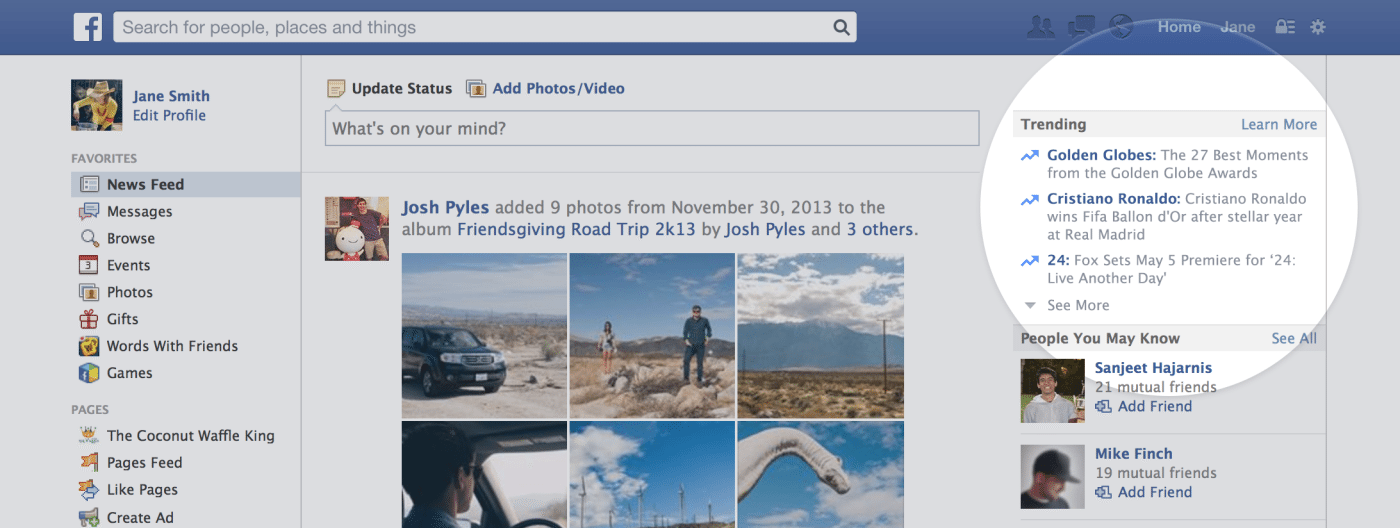
The second element factors in the rate at which users are liking or commenting on a post. Facebook currently looks at total number of likes and comments as a factor in whether or not to display a post in the News Feed. With this latest update, another consideration will be when those likes and comments occur.
What does your perfect Facebook post look like?
Hopefully these best practices have given you some ideas on what to test with your Facebook marketing strategy.
Do you get more engagement when you share an optimized link or a photo?What is your perfect Facebook character count?Can you get more reach by posting at night and on the weekends?
I’d love to hear how these tests go for you and if you’ve found perfect practices for your Facebook page already. Please do share in the comments!
Image sources: Icon Finder, Blurgrounds, Startup Stock Photos, PlaceIt, HubSpot, Facebook, Orbit Media, SumAll
PLEASE UPVOTE AND COMMENT
Hi! I am a robot. I just upvoted you! I found similar content that readers might be interested in:
https://blog.bufferapp.com/anatomy-of-a-perfect-facebook-post
nice
Hi, adulrehmanunion! I just resteemed your post!
I am a new, simple to use and cheap resteeming bot.
If you want to know more about me, read my introduction post.
Good Luck!